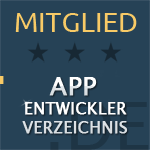
Insight

Insight

Insight
Flutter Migration: Your Step-by-Step Guide to Upgrading to a New Flutter Version


Julian Giesen
·
7
min read
·
Monday, June 2, 2025


Julian Giesen




Photo - ChatGPT
You use Flutter to develop modern and performant apps – impressive! But eventually, there comes a point when you have to upgrade from an older Flutter version, for example, from Flutter 2 to Flutter 3. Maybe because new features are enticing, you want to achieve performance gains, or simply to avoid security vulnerabilities. Such a version switch often seems complicated at first, especially with an app that is already running. But don’t worry: With a clear strategy, you can achieve Flutter project migration smoothly – and get the most out of your project.
In this guide, we will show you step by step how to migrate your Flutter app from Version 2 to Flutter 3 – cleanly, structured, and without nasty surprises. The often-feared Flutter Null Safety Migration is also part of this guide.
Why you should switch to a new Flutter version
More performance, more security
Every new Flutter version brings improvements – whether in speed, memory consumption, or stability. Security patches and bug fixes are also essential to protect your app and user data. If you stick to an old version like Flutter 2, you risk technical debt – hence an upgrade to Flutter 3 makes sense in the long run.
Utilize new features and APIs
Regular updates open up access to new widgets, better development tools, and more efficient APIs. You will work more modern, faster, and easier – if you regularly update your Flutter project. The switch to Flutter 3, in particular, offers many advantages, such as an improved toolchain and more stable null safety support.
Preparation before migration
Before you start the migration of your Flutter project from Version 2 to Version 3, prepare well:
Create a backup: Secure your current code – ideally including Git history.
Read release notes: Inform yourself about all changes between Flutter 2 and Flutter 3, especially regarding null safety migration, breaking changes, and new features.
Update toolchain: Your IDE, CLI, and all plugins should be up to date to avoid compatibility issues when upgrading Flutter to 3.
Step 1: Check current Flutter version
Find out which version you are currently using:
Compare it with the latest version on flutter.dev. For the migration from Flutter 2 to Flutter 3, you should especially check whether your dependencies support the new version – many packages have required adjustments due to the switch to null safety.
Step 2: Upgrade to Flutter 3 & update dependencies
Update Flutter SDK
This step brings you technically up to date. You are essentially performing the Flutter upgrade to Version 3.
Check dependencies in pubspec.yaml
Review your pubspec.yaml to make all used packages compatible with Flutter 3. Use flutter pub outdated to identify incompatibilities – especially with older packages, the migration to null safety can often be a challenge.
With this, you pull all updated dependencies into your project.
Step 3: Code adjustments for the new version
Depending on the size of your project, there are different things you need to adjust in the code:
Remove deprecated widgets or APIs
Adjust method signatures and classes, especially in the context of null safety migration in Flutter
Utilize new APIs or features in Flutter 3
Tip: Use flutter analyze to identify problematic areas. Tools like dart migrate can also assist in the null safety transition.
To develop regression-proof after version migration, check out Test-Driven Flutter Development – A Holistic Approach that shows how testing ensures quality and stability.
Step 4: Testing after migration
After the technical migration, you should thoroughly test your app – especially when you have made the switch from Flutter 2 to 3:
Unit tests: Check the logic of your functions
Integration tests: Ensure that components work together correctly
Manual tests: Test the UI and UX under real conditions
This way, you can ensure that your Flutter project migration has not left behind any regressions or errors.
Common issues during Flutter migration – and their solutions
Incompatible packages
Some packages are not compatible with Flutter 3 or null safety. In such cases:
Use alternative packages
Fork and adjust them yourself
Actively look for maintainer updates
Errors due to API changes
Many breaking changes affect widgets, methods, or type definitions. These are especially common during a Flutter 2 to 3 migration. Release notes will help you here.
Performance issues
After a migration, there can be losses. With flutter devtools, you can analyze bottlenecks and optimize them specifically.
Best practices for future migrations
Regular upgrades: Instead of infrequent large steps, prefer to perform small, frequent migrations
Increase test coverage: A solid test suite secures your project
Use a branching strategy: Test migrations in separate branches
Actively follow Flutter release notes
After you've successfully migrated to Flutter 3, this article will help you further optimize your application: Flutter Performance Tips: How to optimize your app to ensure it runs smoothly and performs well in the new version.
Conclusion: Master migration from Flutter 2 to Flutter 3
The migration between Flutter versions – especially the step from Flutter 2 to Flutter 3 including null safety migration – is a challenge that you can master easily with the right preparation. If you regularly update your dependencies, approach the upgrade in a structured way, and test your app thoroughly, your project will be future-proof, stable, and performant.
Use this guide as a foundation for your own Flutter project migration – and make the upgrade to Flutter 3 a strategic advantage.
Need support?
I have already successfully migrated numerous Flutter projects to new versions – including complex null safety transitions and architectural adjustments. If you desire technical security or want to implement your migration efficiently and without setbacks, I am happy to assist you.
Contact me for a non-binding initial conversation – together we will smoothly bring your Flutter project up to date.
All insights
All insights
“Flutter and the related logo are trademarks of Google LLC. We are not endorsed by or affiliated with Google LLC.”
“Flutter and the related logo are trademarks of Google LLC. We are not endorsed by or affiliated with Google LLC.”
Copyright ©2025. Julian Giesen. All rights reserved.
“Flutter and the related logo are trademarks of Google LLC. We are not endorsed by or affiliated with Google LLC.”





